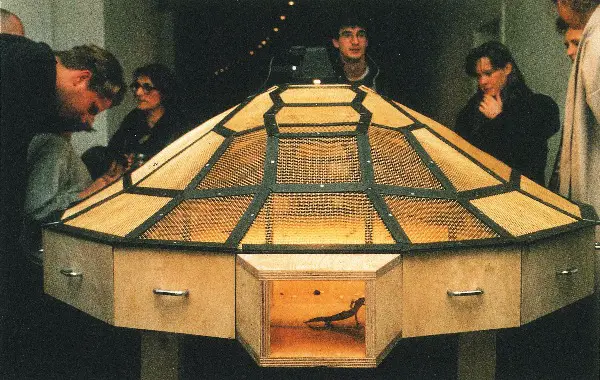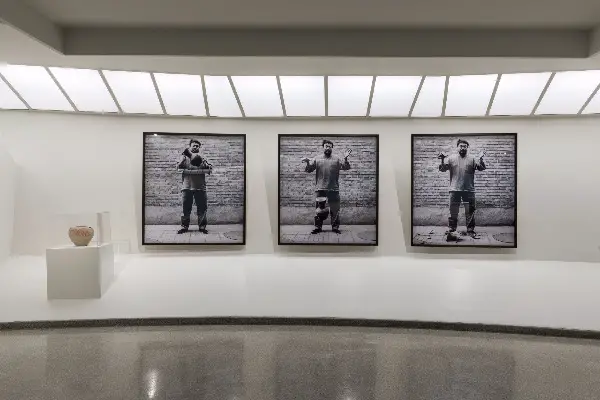The first thing you’ll notice when you enter the Guggenheim to see the exhibit Art and China after 1989: Theater of the World is what appears to be an enormous dragon, hanging overhead. It’s one of the signature pieces in the exhibit, and it’s impossible to miss. It’s 65 feet long and made from bicycle inner tubes; in its body, toy cards are nestled. It’s an image both familiar and strange, which might be the leitmotif of the show. Many of the works on view—and the artists—will most likely be unfamiliar to a number of people, and for that reason alone, it’s worth seeing the show—it provides exposure on a grand scale to a culture both extremely familiar and, literally, foreign.

Installation view: Art and China after 1989: Theater of the World, Solomon R. Guggenheim Museum, New York, October 6, 2017–January 7, 2018. Photo: David Heald.

The exhibition highlights how Chinese artists were both observers and participants in a critical period of Chinese history. The exhibition includes contemporary art from 1989-2008, a period of rapid transformation in China, as well as the world. (The dates bookend the ostensible end of the Cold War, with the falling of the Berlin Wall, and the Beijing Olympics, respectively.) Showcasing the work of 71 artists and collectives, and including close to 150 works, the exhibition is the largest of its kind ever to be shown in North America. The focus is mainly on conceptual art, created during a time when China was entering the world stage, and social and political change were sweeping the country. Artists played a crucial role in documenting these changes; many of the results can be seen here.
The entire museum has been used to full effect: the exhibit—and the visitor—travels up the rotunda and into the two towers at the top of the building. (Patrons should also travel back down the same way, rather than taking the elevator, for a different perspective.)

Huang Yong Ping, Theater of the World, 1993. Wood and steel structure with wire mesh, warming lamps, electric cable, insects (African millipedes, house crickets, goliath beetles, hissing cockroaches, lubber grasshoppers, and stag beetles), leopard geckos, and Italian wall lizards, 150 x 270 x 160 cm, Guggenheim Abu Dhabi, © Huang Yong Ping
One of the first works of art is the one that gave the exhibit its name, and was also the subject of mass protest. “Theater of the World,” by artist Huang Yong Ping, was originally intended to be a large wood and steel cage filled with live reptiles and insects (including Goliath beetles and hissing cockroaches), but was one of three works removed due to protests and fear for visitors’ safety. Now an empty cage is displayed along with wall text. It’s a viable alternative in some ways, although it feels—not surprisingly—unfinished. (The other works were “The Bridge,” an exhibit that included live animals, and two videos.) All were designed to signify oppression, and both sides have come under their fair share of criticism.
Hung Yong Ping does have another work in the show: “The History of Chinese Painting and A Concise History of Modern Painting Washed in a Washing Machine for Two Minutes.” What is it? A Chinese art history tome and an account of Western art, thrown into a washing machine on the spin cycle.
The range of images is vast, covering everything from video projections to wall panels to paintings to sculptural objects. Some purposely cause discomfort, such as images of human bodies, often nude: Others may be less provocative, but equally jarring: a small sewing machine wrapped in thread, covered with images of hands working.
The exhibit is divided into six sections: Be sure not to miss the last one, perched high in Tower 7: a giant scroll covered in what seems to be calligraphy; it's actually the path taken by people carrying the injured after the events at Tiananmen Square.
No matter the path that led there, the one visitors take while traversing the show is well worth it: an unprecedented chance to see artworks they may not see again, from a part of the world that only becomes more vital to the world stage every day.

Installation view: Art and China after 1989: Theater of the World. Solomon R. Guggenheim Museum, New York, October 6, 2017—January 7, 2018. Photo: David Heald © Solomon R. Guggenheim Foundation, 2017.
Art and China after 1989: Theater of the World runs at the Guggenheim through Jan. 7, 2018. For more information, visit guggenheim.org.





